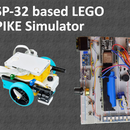Introduction: Hand-held Lottery Number Generator and Temperature and Humidity Meter
This unit shows the actual temperature and humidity level after it booted up. The first two digits on the display represent the humidity, and the second two digits shows the temperate readings. If someone starts shaking the unit it will generate two random decimal numbers. The unit will pick random decimal numbers from the 1 to 90 range in default. The range can be changed with touch buttons. If someone touches one of the buttons, the display shows two decimal numbers. The first is the minimum value of the range and the second number is the maximum value.
Button 1 increases the first digit of the display (the min. value increase with 10).
Button 2 increases the second digit of the display (the min. value increase with 1).
Button 3 increases the third digit of the display (the max. value increase with 10).
Button 4 increases the fourth digit of the display (the max. value increase with 1).
The unit is powered by two AAA batteries. The internal voltage is regulated up 5 V. It has a built in accelerometer which detecting if the unit is moving.
Step 1: PCB and Components
Manufacture the PCB board according gerber files.Or simply build it on a proto board.
BOM list:
1pc TTP224 4- Channel Digital Touch Sensor Module Capacitive Touch Switch
Button
1pc CM0 DIY Capless 2-AAA Battery Holder Cases Boxs w/ Lead Line - Black
1pc Mini Slide Switch DIY Parts - Silver
1pc 1A 3V to 5V DC-DC Converter Step Up Boost Module
1pc 5V-3V IIC UART SPI Four Channel Level Converter Module for Arduino
1pc 4 digital display with adjustable brightness LED module clock Point Accessories Blocks for arduino
1pc ATMEGA328P Pro Mini 328 Mini ATMEGA328 5V 16MHz for Arduino 5V 16M With the bootloader
1pc GY-291 ADXL345 digital three-axis acceleration of gravity tilt module IIC / SPI transmission
1pc DHT-11 DHT11 Digital temperature and humidity sensor probe
1 pc crochet made with Crochet for Gadget
Attachments
Step 2: Assembly PCB and the Components 1.
Steps:
1. Soldering PIN-s on booth side.
2. Install switch. (prototype had small drills, corrected in v12 )
3. Install DHT 11 temperature and humidity sensor. (prototype had only 3 connection because it was planned to use with DHT 22, corrected in v12 booth DHT11 and DHT22 can be used, resistors should decide )
4. Fix battery holder with two screw and solder connection. (prototype had polarity problem, and small drills, corrected in v12 )
Step 3: Assembly PCB and the Components 2.
Upload the attached software.
For uploading or changing the code download and install Arduino Software.
Use a Crius FTDI Basic Breakout 5V USB to TTL 6-Pin Module (other downloader could also work), to connect the PC to the Arduino.
I used the following libraries thanks for them, before using check their licencing:
"Wire.h" //https://www.arduino.cc/en/reference/wire
"ADXL345.h" //https://code.google.com/p/adxl345driver/
“Timer.h” //http://playground.arduino.cc/Code/Timer
"TM1637.h" //https://github.com/reeedstudio/libraries/tree/master/DigitalTube
"DHT.h" //http://playground.arduino.cc/Main/DHTLib
"Timer.h" //http://playground.arduino.cc/Code/Time
1. Upload the program before soldering.
Test the board, than solder it.
2. Solder display, buttons, level shifter,
3. Before solder power regulator step up converter it produce to high Voltage (5.3V), use diodes to reduce the VCC. I used two connected serial.
4. Turn on and enjoy it. video: https://youtu.be/OaifBikhXyg







